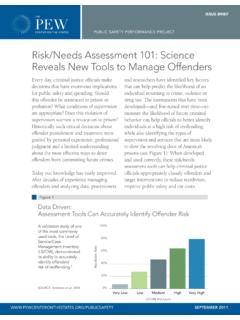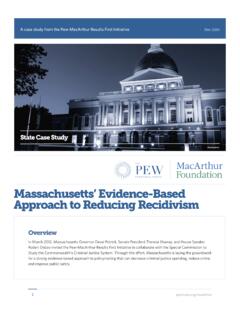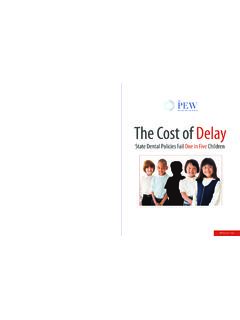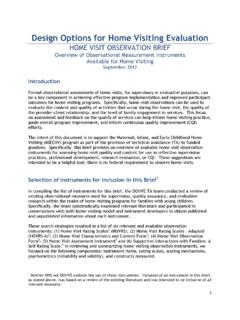Transcription of Evidence-Based Policymaking: A Guide for Effective Government
1 A report from the Pew-MacArthur Results First Initiative Nov 2014. Evidence-Based Policymaking A Guide for Effective Government The Pew Charitable Trusts Susan K. Urahn, executive vice president Michael Caudell-Feagan, vice president John D. and Catherine T. MacArthur Foundation Julia Stasch, interim president Pew-MacArthur Results First Initiative Gary VanLandingham Darcy White Torey Silloway Amanda Hoey Valerie Chang Elizabeth Davies Meredith Klein Senior Advisers Katherine Barrett Richard Greene External Reviewers This report benefited from the insights and expertise of the Results First Research Advisory Panel, which provided critical feedback on various drafts.
2 Members of the panel included: Beth Blauer, director of GovStat at Socrata;. David Coburn, partner at Capital Analytics; Marc Holzer, dean and board of governors professor, School of Public Affairs and Administration, Rutgers University, Newark; Michele Jolin, managing partner, America Achieves; R. Kirk Jonas, director of research compliance and integrity, University of Richmond; John Kamensky, senior fellow, IBM Center for the Business of Government ; Elaine C. Kamarck, senior fellow in governance studies, Brookings Institution; Donald F. Kettl, professor in the School of Public Policy, University of Maryland, College Park; Donald Moynihan, professor, Robert M.
3 La Follette School of Public Affairs, University of Wisconsin, Madison; John O'Brien, former director, Texas Legislative Budget Board; and John Turcotte, director of the Program Evaluation Division, North Carolina General Assembly. Although these individuals have reviewed the report, neither they nor their organizations necessarily endorse its findings or conclusions. Acknowledgments We would like to thank the following Pew colleagues for their insights and guidance: Samantha Chao, Diane Lim, and Karen Lyons. We also thank Kristin Centrella, Jennifer V. Doctors, Jessica Hallstrom, Jennifer Peltak, and Kodi Seaton, as well as former Pew staff member Nicole Dueffert, for providing valuable feedback and production assistance on this report.
4 The Pew Charitable Trusts The John D. and Catherine T. MacArthur Foundation 901 E St. NW. Washington, DC 20004 140 S. Dearborn St. Chicago, IL 60603. The Pew Charitable Trusts is driven by the power of The John D. and Catherine T. MacArthur Foundation knowledge to solve today's most challenging problems. supports creative people and Effective institutions Pew applies a rigorous, analytical approach to improve committed to building a more just, verdant, and public policy, inform the public, and invigorate civic life. peaceful world. In addition to selecting the MacArthur Fellows, the Foundation works to defend human rights, advance global conservation and security, make cities better places, and understand how technology is affecting children and society.
5 Cover photo: 1. 1. Getty Images/Mel Curtis Contact: Gary VanLandingham, director, Pew-MacArthur Results First Initiative Email: Phone: 202-540-6207. Pew-MacArthur Results First Initiative, a project of The Pew Charitable Trusts and the John D. and Catherine T. MacArthur Foundation, works with states to implement an innovative cost-benefit analysis approach that helps them invest in policies and programs that are proved to work. Contents 1 Overview 2 Why Evidence-Based policymaking? 2 A new era in responsible governance Ongoing fiscal pressures 3. Increasing availability of evidence on what works 3. Federal funding incentives 3. Growing interest from state leaders 3.
6 4 Key components of Evidence-Based policymaking Program assessment 4. Budget development 8. Implementation oversight 10. Outcome monitoring 14. Targeted evaluation 16. 18 Conclusion 19 Appendix A: Methodology 20 Appendix B: Potential roles in state Government 23 Endnotes Overview Governments make budget and policy choices each year that have long-term effects on both their fiscal futures and the outcomes they deliver for constituents. Recognition is growing that policymakers can achieve substantially better results by using rigorous evidence1 to inform these decisions, enabling governments to select, fund, and operate public programs more strategically. Until now, however, no comprehensive road map has provided clear guidance on using this approach.
7 To fill this gap, the Pew-MacArthur Results First Initiative has developed a framework that governments can follow to build and support a system of Evidence-Based policymaking. Based on an extensive review of research and in-depth interviews with Government officials, practitioners, and academic experts, the framework identifies steps that both the executive and legislative branches can take to drive the development, funding, implementation, and monitoring of policies and programs. The framework has five key components, each with multiple steps that enable governments to make better choices through Evidence-Based policymaking: (1) program assessment, (2) budget development, (3).
8 Implementation oversight, (4) outcome monitoring, and (5) targeted evaluation. 1. Program assessment. Systematically review available evidence on the effectiveness of public programs. a. Develop an inventory of funded programs. b. Categorize programs by their evidence of effectiveness. c. Identify programs' potential return on investment. 2. Budget development. Incorporate evidence of program effectiveness into budget and policy decisions, giving funding priority to those that deliver a high return on investment of public funds. a. Integrate program performance information into the budget development process. b. Present information to policymakers in user-friendly formats that facilitate decision-making.
9 C. Include relevant studies in budget hearings and committee meetings. d. Establish incentives for implementing Evidence-Based programs and practices. e. Build performance requirements into grants and contracts. 3. Implementation oversight. Ensure that programs are effectively delivered and are faithful to their intended design. a. Establish quality standards to govern program implementation. b. Build and maintain capacity for ongoing quality improvement and monitoring of fidelity to program design. c. Balance program fidelity requirements with local needs. d. Conduct data-driven reviews to improve program performance. 4. Outcome monitoring. Routinely measure and report outcome data to determine whether programs are achieving desired results.
10 A. Develop meaningful outcome measures for programs, agencies, and the community. b. Conduct regular audits of systems for collecting and reporting performance data. c. Regularly report performance data to policymakers. 1. 5. Targeted evaluation. Conduct rigorous evaluations of new and untested programs to ensure that they warrant continued funding. a. Leverage available resources to conduct evaluations. b. Target evaluations to high-priority programs. c. Make better use of administrative data information typically collected for operational and compliance purposes to enhance program evaluations. d. Require evaluations as a condition for continued funding for new initiatives.













